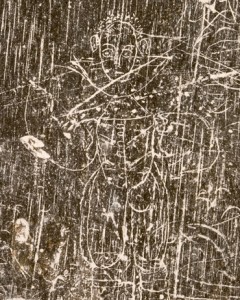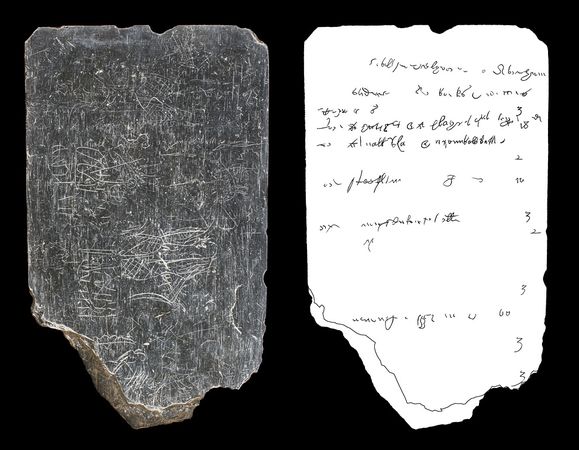 Last June, archaeologists excavating the James Fort area of Jamestown, Virginia, found a 400-year-old slate tablet covered on both sides in words, numbers, etchings of people and animals. It was found in a well believed to have been dug in 1609 by Captain John Smith himself, although it had become brackish within a couple of years and served as a trash pit for the settlers.
Last June, archaeologists excavating the James Fort area of Jamestown, Virginia, found a 400-year-old slate tablet covered on both sides in words, numbers, etchings of people and animals. It was found in a well believed to have been dug in 1609 by Captain John Smith himself, although it had become brackish within a couple of years and served as a trash pit for the settlers.
Jamestown was the first permanent English settlement in America and this tablet is the first found with extensive inscriptions from the early colonial period. It has been studied assiduously in the 7 months since its find, most recently by examining digitally enhanced images of the complex engravings.
The enhancements have helped researchers identify a 16th-century writing style used on the slate and discern new symbols, researchers announced last week. The characters may be from an obscure Algonquian Indian alphabet created by an English scientist to help explorers pronounce the language spoken by the Virginia Indians.
“Just like finding the Rosetta Stone led to a better understanding of the Egyptians, this tablet is beginning to add significantly to our understanding of the earliest years at Jamestown,” [director of research and interpretation at Historic Jamestowne William] Kelso said. It conveys messages about literacy, art, symbols and signs personally communicated by the colonists who used it, he explained.
The digital images were made by curators at the Smithsonian’s Museum Conservation Institute using a technique called reflectance transformation imaging, which takes hundreds of high-res pictures of the surface of the tablet under different angled lights. This emphasizes different grooves on the tablet’s surface. It’s like when you tilt your head and hunker down and narrow your eyes to find any marks you couldn’t see looking straight down on a shiny surface.
Can you tell I just kneaded some dough on a granite countertop? Only this is even worse because many of the images were made with a slate pencil on the slate surface, so they’re gray-on-gray and hard to see with the naked eye under any circumstance.
The Elizabethan specialists have found the words “Abraham” and “book” as well as some individual letters, but since the tablet was reused, there are many missing parts. The Elizabethan writing is in secretary’s hand, which supports Kelso’s theory that the tablet belonged to William Strachey, the first secretary of the Jamestown colony.
There’s drawing of a Palmetto tree and what may be a cahow, a rare sea bird found only in Bermuda. Strachey was stranded in Bermuda for 10 months on his way to Virginia.
